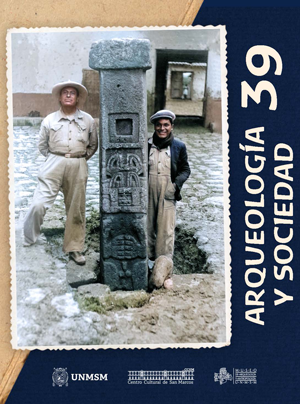The quero and the aryballos: a complementary reading
DOI:
https://doi.org/10.15381/arqueolsoc.2023n39.e25644Keywords:
Inca art, inconography, queros, aryballus, art historyAbstract
Featured by the use of geometric designs, schematic figurative representations, and the importance of composition over pictorial details (Cummins, 2018), the Inca art had the role of diffusion of a power discourse and legitimation of the ruler regimen (Herring, 2021; Bray, 2000 and, Moseley, 1992). This paper, through the observation of Inca quero
(qquero, wooden glass) and aryballos (urpu) of Cuzco Polychrome A and B style, with the revision of colonial documents and archaeological information, proposes an iconographic approximation about the concentric square carved motifs on the Inca queros. Read complementarily with the rhombus and phytomorphic motifs painted on the aryballos, the squares refer to the caves (also called “windows”) of Sutictocco and Marastocco, men- tioned in the Inca origin myths with the Tamboctocco’s cave and, by extension, to the subjects and allies of the Inca, being part of a message of legitimation through the theme of the mythic origin.
Downloads
Published
Issue
Section
License
Copyright (c) 2023 Álvaro Cortijo Molina

This work is licensed under a Creative Commons Attribution 4.0 International License.
THE AUTHORS RETAIN THEIR RIGHTS:
a. The authors retain their trademark and patent rights, and also on any process or procedure described in the article.
b. The authors retain the right to share, copy, distribute, perform and publicly communicate the article published in the Arqueología y Sociedad (for example, place it in an institutional repository or publish it in a book), with an acknowledgment of its initial publication in the Arqueología y Sociedad.
c. The authors retain the right to make a subsequent publication of their work, to use the article or any part of it (for example: a compilation of their works, notes for conferences, thesis, or for a book), provided that they indicate the source. of publication (authors of the work, journal, volume, number and date).






